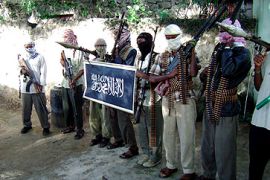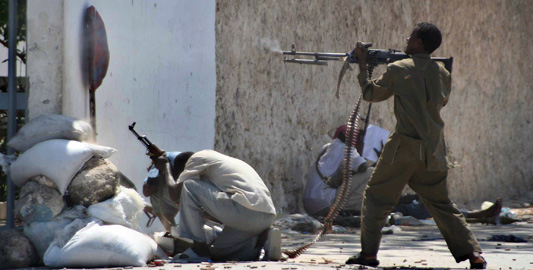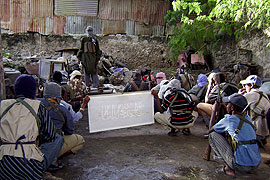Somali fighters undeterred
Al Jazeera’s Mohammed Adow looks at the rise of Somalia’s feared al-Shabab militia.

 |
| Al-Shabab say they will fight on despite the death of their leader in a US air raid [EPA] |
It is a popularly held belief in Africa that Somalia often has a way of springing back into the international limelight – its long-running wars and conflicts are never short of surprises.
After all, it is in Somalia that the meaning of the term “warlord” was perfected by a group of clan leaders who carved the country into armed fiefdoms.
It is here that UN and US peacekeepers hurriedly left in the 1990s after suffering some of the worst casualties and humiliation in the history of peacekeeping initiatives.
|
Related link |
It was within this power vacuum generated by the lack of a central government – and the absence of an international presence – that a group of Islamic scholars came together and formed the Islamic Courts Union (ICU) to impose law and order.
The Islamic Courts were initially set up by traders in Mogadishu, frustrated with the high levels of insecurity in the capital, to try petty criminals. Nearly every clan in Mogadishu had its own court. No clan or sub-clan could try a suspect from another clan.
Between 2002 and 2003 a group of Somali youth, angry with the lack of progress in attempts to establish a government, joined ranks to push their goal to create (by any means necessary) a state governed by Islamic Sharia law.
Now, 18 years after Somalia began its slow descent into anarchy, it is again the setting for one of the bloodiest wars in Africa’s recent history.
Al-Shabab militias
The war in Somalia is being sustained by armed Islamist and clan militias.
Chief among them is the al-Shabab (the youth, in Arabic) militia – the former military wing of the deposed ICU that ruled Somalia before the Ethiopian-led invasion in 2007.
Little is known about the al-Shabab but it is considered to be a well-organised, hierarchical organisation that really means business.
They are no bolt from the blue – they were there long before the Islamic Courts united to engage in politics.
The al-Shabab masterminds were led by, among others, Adan Hashi Ayro – the group’s military leader who was killed in a US missile attack on May 1.
It is believed that Adan Ayro and his fellow al-Shabab patrons were trained in Afghanistan. They built the al-Shabab on the tenets of the Taliban – the former rulers of Afghanistan.
The al-Shabab first emerged when they began combatting criminal gangs who had been in control of Mogadishu’s roads – in effect, modern-day highwaymen.
Once the al-Shabab chased the gangs out of the city, they then turned to destroying the major kidnapping rings that had become a huge business in the Somali capital.
This pit the Islamist youth in direct conflict with the warlords who received kickbacks from the kidnapping rings in and around Mogadishu.
Seeking legitimacy
 |
| Al-Shabaab fighters receive instruction on guerrilla warfare tactics [EPA] |
But the al-Shabab militia was considered a rogue vigilante group and needed public legitimacy and support if they were to take on the better-armed warlords whose territories they crisscrossed.
They found their perfect source of legitimacy in the clan-based Islamist courts system and soon became the backbone of the ICU’s military strength.
This alarmed the US, which always regarded Somalia as a possible safe haven for groups it considered to be global “terrorists”.
It responded by supporting the warlords – sworn enemies of the ICU.
Though the US government never directly confirmed its support for the warlords, Sean McCormack, then US state department spokesman, said in a May 2006 press conference: “[The US would] work with responsible individuals … in fighting terror.
“It’s a real concern of ours – terror taking root in the Horn of Africa. We don’t want to see another safe haven for terrorists created. Our interest is purely in seeing Somalia achieve a better day.”
By 2006, with the influence of the Islamists growing, a new civil war broke out in Somalia as an alliance of US-backed Mogadishu-based warlords and businessmen known as the Alliance for the Restoration of Peace and Counter-Terrorism (ARPCT) clashed with militias seeking to rule by Sharia law.
The warlords lashed back and attacked homes of Muslim imams, some of whom they handed over to the US.
In February 2006, the al-Shabab and ICU declared a jihad against the ARPCT.
Bolstered by youths happy with their cause and most of Mogadishu’s business community, the Islamist militia dealt the warlords severe blows. The last of their duels in mid-2006 put Mogadishu firmly in their hands after the warlords fled in panic and defeat.
Pacifying Mogadishu
After achieving what many thought was unachievable – pacifying Mogadishu – al-Shabab and other ICU militias began gaining new ground.
They attacked other towns held by warlords and brought them under their influence.
And for some time the movement appeared unstoppable on the battlefield.
This terrified the weak and powerless government which had been isolated in a corner in the Provincial Capital of Baidoa. It also sent a wave of panic across the Horn of Africa, particularly in neighbouring Ethiopia which is home to a large population of its own Muslims and is known for its intolerance of Islamist movements.
When the Ethiopian forces came to defend the frail transitional federal government in late 2006 al-Shabab did what they knew best – attack in the name of Allah.
They suffered one of the quickest and most brutal defeats. But they vowed to carry on. Even US air strikes against their hideouts in a jungle along the Kenya-Somalia border did little to deter them.
They quickly re-grouped and found their way back to the capital where they engaged in guerrilla warfare against Somalia government and Ethiopian forces.
Recently, the Islamist fighters have become more brazen, carrying out attacks in daylight and seizing control of towns in southern and central Somalia.
Honoured by US
When the US recently put al-Shabab on its list of terrorist organisations it was a source of celebration for them. Sheikh Muktar Robow, an al-Shabab leader, welcomed US action against his followers.
“Al-Shabab feels honoured to be included on the list. We are good Muslims and the Americans are infidels. We are on the right path,” he told Al Jazeera.
No one knows for sure where al-Shabab gets its support. The US has in the past accused Eritrea and some Arab nations of funding the conflict being waged by al-Shabab in Somalia. It is a claim Eritrea has vehemently denied.
No doubt the death of Adan Hashi Ayro will be a huge setback to the al-Shabab. He was not only their patron but chief militia trainer. Ayro hailed from one of the most influential clans in Southern Somalia and this earned the al-Shabab admiration, support and ability to recruit militiamen from huge swathes of Somalia.
Though they have the support of some Somalis, the al-Shabab militia says it will not engage in negotiations with the transitional government and will not lay down arms until it has achieved its Islamist goals in the country.
This has left many war-weary Somalis fearful that al-Shabab is becoming an impediment to any negotiated settlement and the conflict fin their country might be far from over.